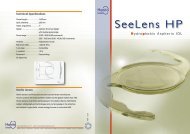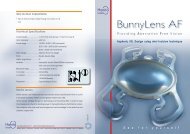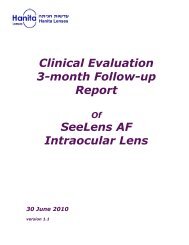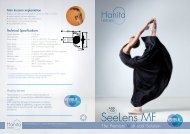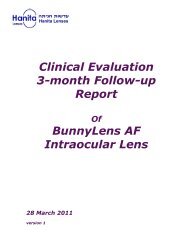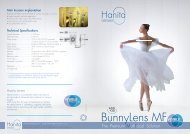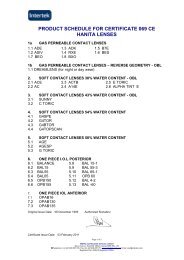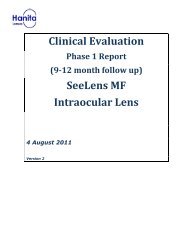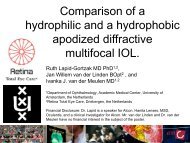Clinical Evaluation 1 to 3 months Follow Up Report SeeLens HP Intraocular Lens
SeeLens HP - Clinical Evaluation Report 11/03/2012 - Hanita Lenses
SeeLens HP - Clinical Evaluation Report 11/03/2012 - Hanita Lenses
- No tags were found...
Create successful ePaper yourself
Turn your PDF publications into a flip-book with our unique Google optimized e-Paper software.
Page 4 of 11Ver. 13.1.2 <strong>See<strong>Lens</strong></strong> <strong>HP</strong> designMotivation – visual acuityHanita <strong>Lens</strong>es search for vision quality improvements has a shared objective for bothrefractive and cataract surgery. The main goal for the refractive and cataract surgery is <strong>to</strong>provide the patient with the best visual acuity and good post operative refraction thatcurrent technology allows.The quest for an improved visual acuity for the cataract patient led Hanita <strong>Lens</strong>es <strong>to</strong>develop an aspheric-shaped lens. Designed <strong>to</strong> allow the patient a sharper image in theregular pho<strong>to</strong>pic vision (daylight vision), and reduce the aberrations of mesopic andsco<strong>to</strong>pic vision (twilight and night vision), which are noticed by some of the conventionalspherical Intra Ocular <strong>Lens</strong> implanted patients.Figure 2: The Black line defines the pho<strong>to</strong>pic vision and the green line defines the sco<strong>to</strong>pic vision.The area between the graphs defines the sco<strong>to</strong>pic vision.Hydrophobic material – preventing PCOThe <strong>See<strong>Lens</strong></strong> <strong>HP</strong> is made of hydrophobic acrylic material, which is known <strong>to</strong> be superiorin postponing the posterior capsular opacification (PCO), thus reducing the need for theYAG laser treatment. Moreover, hydrophobic materials are known <strong>to</strong> be more stablewithin the posterior capsule with respect <strong>to</strong> the hydrophilic lenses due <strong>to</strong> its higherstiffness with respect <strong>to</strong> the hydrophilic acrylic material. The <strong>See<strong>Lens</strong></strong> <strong>HP</strong> aspheric opticaldesign is identical <strong>to</strong> the <strong>See<strong>Lens</strong></strong> AF, Hanita <strong>Lens</strong>es’ premium product. The <strong>See<strong>Lens</strong></strong> <strong>HP</strong>is made of a different raw material, BENZ HF-1.2 Natural Yellow. This material haschemical composition very similar <strong>to</strong> the backbone structure of the BENZ IOL 25 NaturalYellow material.Spherical aberrationThe spherical aberration is a well known phenomenon in the optic field. The sphericalaberration occurs when rays of light that pass through different parts of the lens intersectat different points on the optical axis of the lens (Figure 3). Due <strong>to</strong> this aberration, a dotHanita <strong>Lens</strong>es <strong>Intraocular</strong> & Contact <strong>Lens</strong>esעדשות חניתהעדשות מגע ועדשות השתלה תוך-עינית•קיבוץ חניתה • 88222 www.hanitalenses.com Kibbutz Hanita 22885 Israel • Tel. 972-4-9950 700• Fax: 972-4-9950 755 •



